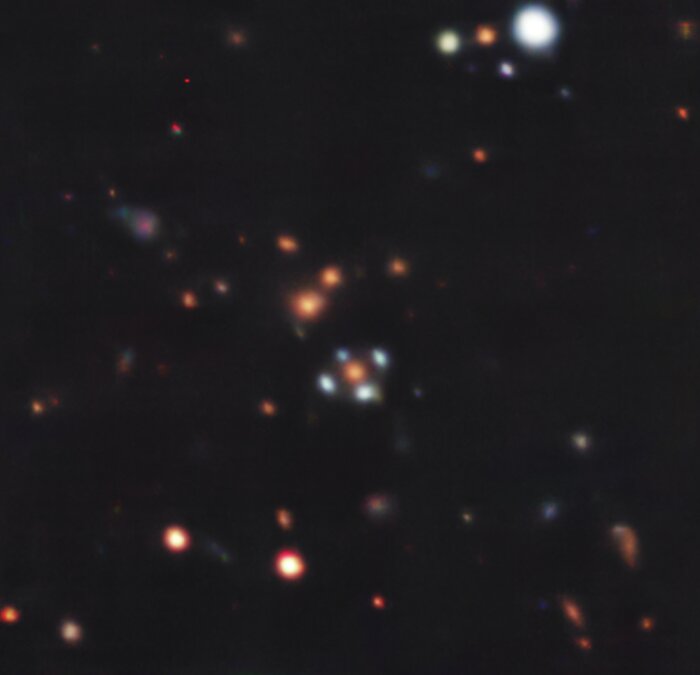A flower with four petals (full field of view)
There are several galaxies in this Picture of the Week, but the most fascinating is probably the one surrounded by four light-blue dots, resembling a flower with blue petals. But, are these dots real? Yes and no… Taken with ESO’s Very Large Telescope (VLT), this image shows a so-called Einstein Cross.
The four ‘petals’ are images of a distant galaxy hidden behind the orange galaxy at the centre. Something very fascinating happens to allow us to detect the light from this hidden object: the galaxy at the centre acts as a gravitational lens, bending the light emitted from the distant galaxy around it. As a result, we see several images of the distant galaxy, distorted and magnified. In the special configuration of these two galaxies, the hidden one appears as four images around the central ‘lens’ galaxy, forming a cross-like (or flower-like) pattern dubbed an Einstein Cross. Gravitational lensing thus allows us to discover hidden galaxies that would be otherwise invisible to us.
The observations of this system were conducted with the Multi Unit Spectroscopic Explorer (MUSE) instrument at ESO’s VLT in Chile. MUSE splits the light coming from every point within the area being observed into a rainbow or spectrum, which provides astronomers with a wealth of information about the objects within the field of view. The results of these observations, presented in a new paper led by Aleksandar Cikota at the Gemini Observatory in Chile, show that the distant galaxy is forming stars at a rapid rate[1]. Since light left the galaxy when the Universe was about 20% of its current age, studying it provides clues about how galaxies formed in the early Universe.
Note
[1] The expansion of the Universe makes distant galaxies appear redder than if they were closer to us. That being said, the four images of the distant galaxy here look blue due to the presence of young stars. The lens galaxy at the centre is closer to us, but it looks red as it’s largely composed of old stars.
Link
Credit:ESO/A. Cikota et al.
About the Image
| Id: | potw2337b |
| Type: | Observation |
| Release date: | 11 September 2023, 06:00 |
| Size: | 942 x 908 px |
About the Object
| Type: | Early Universe : Galaxy : Type : Gravitationally Lensed |
| Constellation: | Hercules |
| Category: | Galaxies |
Wallpapers
Coordinates
| Position (RA): | 16 53 0.88 |
| Position (Dec): | 26° 53' 6.53" |
| Field of view: | 1.05 x 1.01 arcminutes |
| Orientation: | North is -0.0° left of vertical |
Colours & filters
| Band | Wavelength | Telescope |
|---|---|---|
| Optical g | 550 nm | Very Large Telescope MUSE |
| Optical r | 625 nm | Very Large Telescope MUSE |
| Optical i | 775 nm | Very Large Telescope MUSE |

